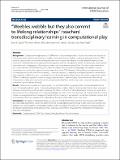| dc.contributor.author | Gravel, Brian E. | |
| dc.contributor.author | Millner, Amon | |
| dc.contributor.author | Tucker-Raymond, Eli | |
| dc.contributor.author | Olivares, Maria C. | |
| dc.contributor.author | Wagh, Aditi | |
| dc.date.accessioned | 2022-09-26T13:42:33Z | |
| dc.date.available | 2022-09-26T13:42:33Z | |
| dc.date.issued | 2022-09-20 | |
| dc.identifier.uri | https://hdl.handle.net/1721.1/145564 | |
| dc.description.abstract | Abstract
Background
Computational approaches in STEM foster creative extrapolations of ideas that extend the bounds of human perception, processing, and sense-making. Inviting teachers to explore computational approaches in STEM presents opportunities to examine shifting relationships to inquiry that support transdisciplinary learning in their classrooms. Similarly, play has long been acknowledged as activity that supports learners in taking risks, exploring the boundaries and configurations of existing structures, and imagining new possibilities. Yet, play is often overlooked as a crucial element of STEM learning, particularly for adolescents and adults. In this paper, we explore computational play as an activity that supports teachers’ transdisciplinary STEM learning. We build from an expansive notion of computational activity that involves jointly co-constructing and co-exploring rule-based systems in conversation with materials, collaborators, and communities to work towards jointly defined goals. We situate computation within STEM-rich making as a playful context for engaging in authentic, creative inquiry. Our research asks What are the characteristics of play and computation within computational play? And, in what ways does computational play contribute to teachers’ transdisciplinary learning?
Results
Teachers from grades 3–12 participated in a professional learning program that centered playful explorations of materials and tools using computational approaches: making objects based on rules that produce emergent behaviors and iterating on those rules to observe the effects on how the materials behaved. Using a case study and descriptions of the characteristics of computational play, our results show how familiarity of materials and the context of play encouraged teachers to engage in transdisciplinary inquiry, to ask questions about how materials behave, and to renegotiate their own relationships to disciplinary learning as they reflected on their work.
Conclusions
We argue computational play is a space of wonderment where iterative conversations with materials create opportunities for learners to author forms of transdisciplinary learning. Our results show how teachers and students can learn together in computational play, and we conclude this work can contribute to ongoing efforts in the design of professional and transdisciplinary learning environments focused on the intersections of materiality, play, and computation. | en_US |
| dc.publisher | Springer International Publishing | en_US |
| dc.relation.isversionof | https://doi.org/10.1186/s40594-022-00373-9 | en_US |
| dc.rights | Creative Commons Attribution | en_US |
| dc.rights.uri | https://creativecommons.org/licenses/by/4.0/ | en_US |
| dc.source | Springer International Publishing | en_US |
| dc.title | “Weebles wobble but they also commit to lifelong relationships”: teachers’ transdisciplinary learning in computational play | en_US |
| dc.type | Article | en_US |
| dc.identifier.citation | International Journal of STEM Education. 2022 Sep 20;9(1):60 | en_US |
| dc.identifier.mitlicense | PUBLISHER_CC | |
| dc.eprint.version | Final published version | en_US |
| dc.type.uri | http://purl.org/eprint/type/JournalArticle | en_US |
| eprint.status | http://purl.org/eprint/status/PeerReviewed | en_US |
| dc.date.updated | 2022-09-26T12:31:49Z | |
| dc.language.rfc3066 | en | |
| dc.rights.holder | The Author(s) | |
| dspace.embargo.terms | N | |
| dspace.date.submission | 2022-09-26T12:31:49Z | |
| mit.license | PUBLISHER_CC | |
| mit.metadata.status | Authority Work and Publication Information Needed | en_US |
